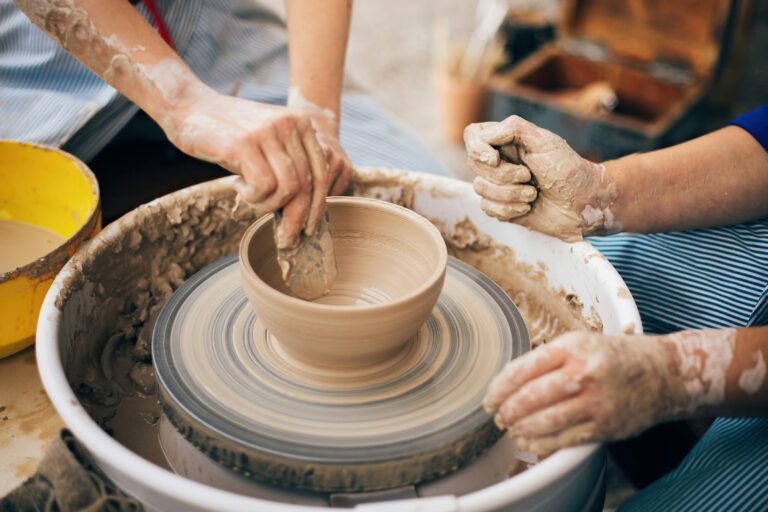Jeremy Casson is a leading art conservator in the UK who runs his own practice, mentoring other conservators. This article will look at the art of pottery, providing pointers and tips to help beginners learn how to throw.
Learning to master the potter’s wheel can be an extremely challenging process, and it demands a great deal of patience and practice. Just like learning to play the piano or drive a car, learning to throw can be frustrating at times. However, though there are no magic tricks, with the right instructions, beginners can learn the art of throwing in no time.
To be successful, potters must learn the theory of wheel throwing, acquiring practical skills as they go. The earlier they understand how the clay responds to the forces they and the wheel are placing on it, the easier the process will become.
When throwing, potters can make life a lot easier for themselves by ensuring their elbows are braced against something. Some experienced potters recommend bracing the left elbow against the left hip with the right forearm on the splash pan, with the arms only becoming free when the pot is nearing completion.
In pottery, speed is crucial. The wheel must start fast, gradually turning more slowly. Although it may seem counterintuitive, centring should be done with the wheel at full speed, as the faster the wheel is turning the easier it will be. Once the pot is centred, the potter should shift down the gears as the pot increases in size. The taller the pot, the greater the centrifugal forces upon it, with thinner walls making it more likely to flop. When opening out and compressing the base, the wheel should be turning at three-quarters speed, moving up to half speed as the potter pulls out the walls. The taller the pot grows, the slower the wheel should turn.
To ensure consistency, potters should weigh their clay to make sure they are practicing with the same amount each time they throw. Wedging the clay or putting it through a pug mill before throwing makes centring easier. Centring the clay right in the middle of the wheel will make life much easier than attempting to centre it later on.
Hot clay is a telltale sign that it is time to lubricate the hands with more water. The amount of water used while throwing is key. Only with experience will the potter get their water usage right, but sticky clay is a surefire way of producing a crooked pot. At the same time, however, it is equally important to avoid using too much water, as this will culminate in clay ebbing away into the splash pan, with the piece growing smaller and smaller. In addition, if the clay absorbs too much water, the walls will fold and the shape will flop. To achieve the right balance, the potter should throw with a trickle of warm water. Rather than flooding the pot, the potter should apply just enough water to keep it glossy. Warm water is easier on the hands; cold water will affect their responsiveness, resulting in numbness and affecting the ligaments and muscles.
Learning to throw clay is like learning to ride a horse. Like a wild animal, clay requires a solid understanding of its behaviour to work with it rather than against it. Becoming a master potter is a long and arduous process for most people that demands patience and perseverance. When learning to throw on a wheel, it is a virtual impossibility to centre on the first try. Beginners should give themselves time, focussing on the process rather than the destination, keeping their hands linked and using their sponge as a water reservoir.


